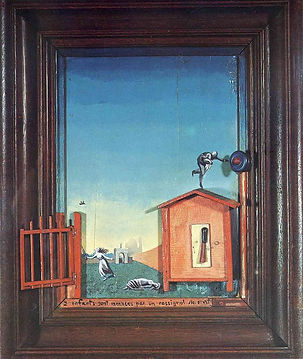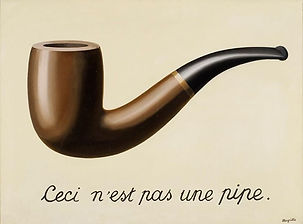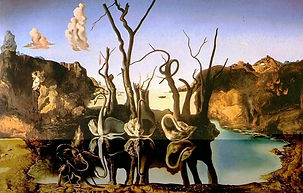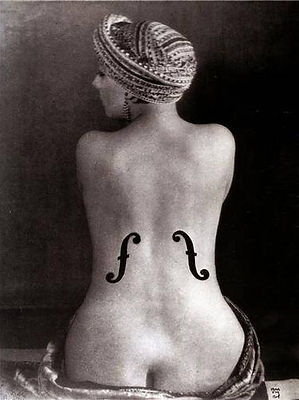
Works
The following works have been selected by our group, these are the favorites of the members, believeing that they are excellent representatives of the Surrealist movement, we hope you enjoy the gallery.

Two Children are Threatened by a Nightengale, 1924
Max Ernst
Oil on wood with wood construction
One of Ernst’s most famous and Iconic paintings is this Surrealist masterpiece titled “Two Children Are Threatened By A Nightingale” in which was inspired by a dream he had as a young child in bed with the measles. This painting is a Dreamscape assemblage in where two girls are frightened by a small bird. He came up with the title through a poem he wrote which began “as night falls, at the edge of town, two children are threatened by a nightingale”.

Carnival of Harlequin, 1924-1925
Joan Miro
Oil on canvas
This painting is one of Miro’s most famous artworks and its one of the first surrealist paintings he did where his lively sense of caprice has been given full rein. In this painting there are many seemingly random objects juxtaposition and almost all evenly spaced apart. Some of the inanimate objects depicted are given eyes and ears so as to animate them, which was a favorite surrealist theme.

Son of Man, 1964
René Magritte
Oil on Canvas
116 cm × 89 cm (45.67 in × 35 in)
Private Collection
In the painting, a man in an overcoat and a bowler hat stands in front of a low wall, behind the wall is the sea and a cloudy sky. The man's face is mostly obscured by a hovering green apple. If you look closely, his eyes can be seen peeking over the edge of the apple and his left arm appears to bend backwards at the elbow.

Emprire of Light, 1954
René Magritte
Oil on canvas
76 15/16 x 51 5/8 inches (195.4 x 131.2 cm)
The subject of the painting is a dark, nocturnal street scene is set against a pastel-blue, light-drenched sky spotted with fluffy clouds. “With no fantastic element other than the single paradoxical combination of day and night, René Magritte upsets a fundamental organizing premise of life”. Instead of being a source of clarity, the sunlight is the cause of confusion and unease, the luminosity of the sky is somewhat unnerving, the darkness below even more impenetrable.

The Treachery of Images, 1929
René Magritte
Oil on Canvas; 23 ¾ x 31 15/16 x 1 in.
Mr. and Mrs. William Preston Harrison Collection
Inspired by Freudian psychology and Modern philosophy, Rene Magritte reveals the paradox inherent with art; wherein a real world subject is painted in facsimile and defined as the object and not for what it is, paint on a canvas. Written in French, “this is not a pipe,” Magritte sought to expose the absurdity of using language (the abstract) to define a simulated (simulacrum) object (physical).

The Eye, 1932-35
René Magritte
Oil on Canvas; 10½ x 10 x 2½ in.
Art Institute of Chicago
René Magritte’s paintings “challenge the real world,” depicting a woman peeking through a hole, only her eye visible, staring back at the watcher. The painting causes the viewer discomfort, their relationship to art perverted; it invades the audiences’ privacy, drawing attention to the personified link between subject within the frame and without.
Swans Reflecting Elephants, 1937
Slavador Dali
Oil on canvas
This painting was part of Dali’s Paranoiac-critical method period in which was a major part of his career. The way he distorts shapes such as the clouds and uses the tree branches to look like elephant trunks is what makes this painting such a major component in Surrealism art. The hallucination of the elephant bodies in the lake and the details in the left rock make this more than just a painting of a landscape.


The Wood, 1927
Max Ernst
Oil on canvas
National Museum Wales
Max Ernst is credited for the creation of the Surrealist painting technique grattage, which involves laying a canvas prepared with a layer of oil paint over a textured object and then scraping the paint off to create an interesting and unexpected surface. The forest and birds that lived there disturbed Ernst yet he has many paintings in which he paints his fears.

The Hallucinogenic Toreador, 1970
Salvador Dali
Oil paint on Canvas
Salvador Dali Museum
Salvador Dali is the most notable figure in Surrealism to date. The scene in The Hallucinogenic Toreador is that if the Bull fighter, famed in Spanish culture, and despised as a savage and sadistic ritual elsewhere in the world, and also depicts the Venus de Milo. Dali, although famed as a Surrealist, broke ties with the group of Surrealist later in his career.

Le Violon d’ Ingres, 1924
Man Ray
Gelatin Silver Print
Getty Museum, Los Angeles, CA.
Man Ray was a great Surrealist and Dadaist. Most noted for his photographs, Man Ray used many different processes to create his visual effects including double exposure, combining printing, montages, and solarization (a method that records the image on a negative.) Photography was an integral part of Surrealism, capturing events and items deemed necessary in surrealist visions.